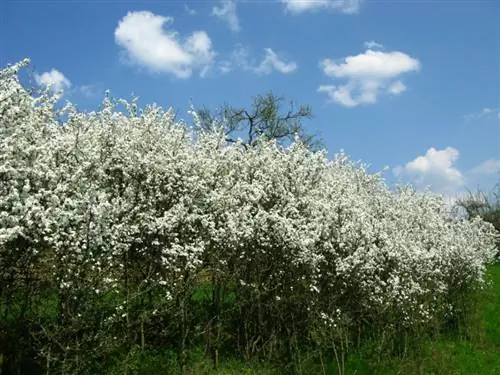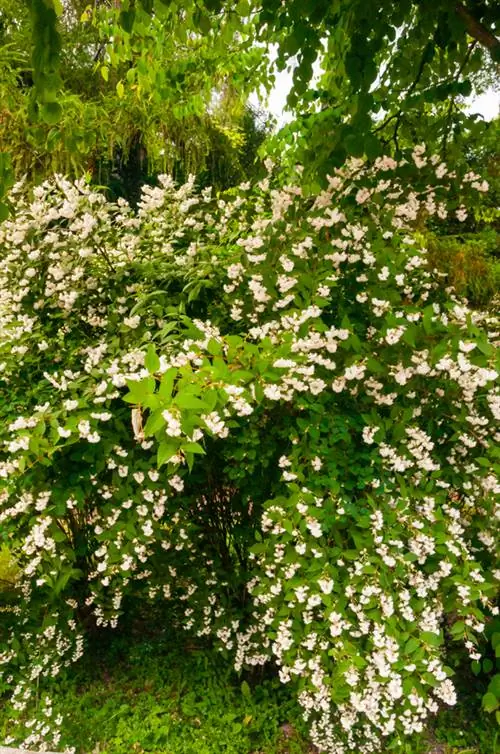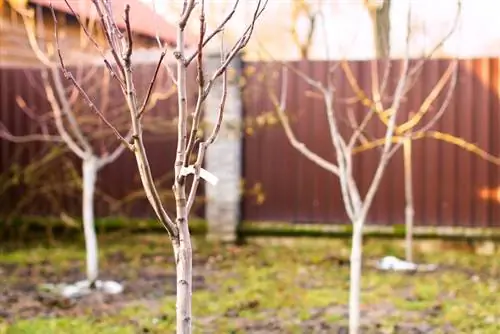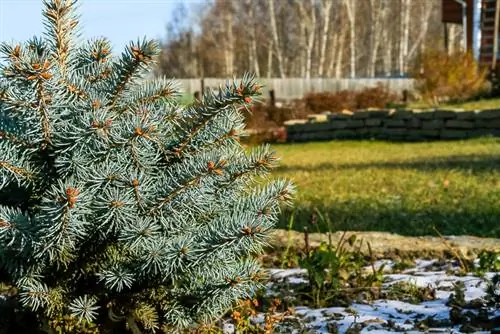- Author admin [email protected].
- Public 2023-12-25 17:45.
- Last modified 2025-06-01 06:02.
The rhododendron can be found in fossils from the Tertiary period and is therefore a very old plant species. It originally comes from the Himalayas. In Dresden, Herrmann Seidel planted the first hardy rhododendron hybrids in 1865.
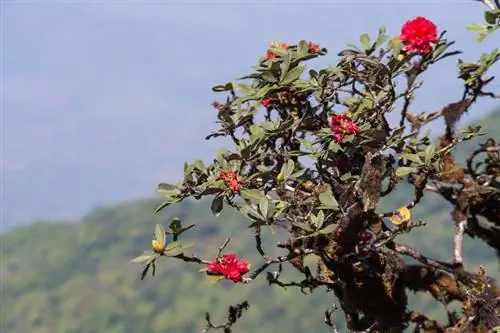
Where should you plant rhododendron?
For an optimal rhododendron location, semi-shady places under deep-rooted trees such as oak, pine or fir are ideal. The soil should be thin, acidic and humic with a pH of 4.0 to 5.0 and there should be high humidity.
Rhododendrons are part of the heather family (Ericaceae). There are 1150 species worldwide. 10 of these are native to Germany and are undoubtedly among the most beautiful flowering trees.
- Rhododendron ferrugineum
- Rhododendron hirsutum
- Rhododendron tomentosum
- Rhododendron Caucasicum
- Rhododendron Lapponicum
- Rhododendron Luteum
- Rhododendron Myrtifolium
- Rhododendron Ponticum
- Rhododendron smirnowii
- Rhododendron ungernii
In 2000 alone, German nurseries produced 20 million rhododendrons.
Rhododendron location - sun or shade?
When you replant or move a rhododendron, the question arises: Where is the optimal location? Which soil does the evergreen ornamental shrub prefer?
Rhododendrons love light and shade under deep-rooted trees such as oak, pine and fir. Light foliage or a canopy of needles provides protection from direct midday sun and acts as an ideal backdrop for the voluminous rhododendron flowers. They thrive best in high humidity on thin, acidic humus layers with a pH value of 4.0 to 5.0.
Sowing and planting rhododendrons, what should you pay attention to?
You can plant home-grown rhododendrons from the third pair of leaves onwards. But beware! The seedlings dry out quickly and are not yet particularly resilient. Low amounts of fertilizer promote growth. With patience you will be rewarded with the first flowers in the second year at the earliest.
When planting young rhododendrons, the planting hole should be about 3x as large as the ball. Please note that rhododendrons have shallow roots. Therefore, make the opening more wide than deep. Mix half of the excavated material with peat.
Well moistened, place the rhododendron in the middle of the planting hole. Fill with the excavated soil mixture and press down lightly. Then pour in - done.
Can you grow rhododendrons from seeds?
If you want to prefer rhododendrons, collect the more voluminous, fertilized seed capsules in autumn. In a dry, warm place they will open after about a week.
To prefer: fill special rhododendron cultivation soil approx. 5 cm high in the cultivation tray. Spread some finely sifted moist peat on top. Sow rhododendron seeds over it and moisten with a fine spray mist. As an Ericaceae, rhododendrons germinate in light and do not need to be covered with soil! Keep moist under a transparent hood in a bright, warm place without direct sunlight. After about four weeks the seedlings will sprout.
Transplanting rhododendrons - when is the best time?
A rhododendron prefers a partially shaded location and acidic soil with a pH value of 4.0 to a maximum of 5.5.
Early autumn or spring are equally recommended for rhododendrons in pots or gardens. As with all evergreen shallow-rooted trees, they need enough time after transplanting to root firmly before the first freezing temperatures.
Propagate rhododendrons - is it worth it?
Rhododendrons awaken the passion of many hobby gardeners for collecting. Because the joy of successfully creating two or more from one plant is fun and cheaper than buying one. But requires time and patience. Most rhododendron varieties can be propagated by grafting them. Propagating through offshoots or cuttings is only recommended for certain rhododendron varieties. You can find the 7 most common propagation practices at a glance here.
When is the best time to plant rhododendrons
To plant rhododendrons, as with other trees, the best time is autumn from early September to mid-November. The spring planting season begins in early March to mid-May until the leaves emerge. Provided it is plus temperatures and the ground is no longer frozen.
Rhododendron harvest time and flowering time - just ornamental or ecologically useful?
Do you like to surround yourself with lush flowers in the garden? Then not only the evergreen, hardy rhododendrons, but especially the colorful ones in the flowering period from January to August are an eye-catcher for your senses. The 3 to 6 mm long capsule fruits are also just a feast for the eyes.
Because these are inedible for humans and animals - but every poison is also medicine. Asian rhododendrons are used as a heart strengthening and blood pressure lowering drug. Siberian Rhododendron chryseum is recommended homeopathically for gout and rheumatism.
Rhododendron substrate - does that make sense?
In general, a substrate loosens the soil, ensures good air permeability and optimal nutrient supply. Special rhododendron substrate has a pH value of 4.0 to 5.0. In addition, the lava or slate contained in it store water and prevent waterlogging. This also prevents mold from forming in the soil.
In contrast to potting soil, nutrients do not wash out, but are solidly available to the rhododendron in lava and mineralized algae. This means you don't have to constantly change the soil or fertilize excessively - and it's peat-free and therefore ecologically valuable!
Rhododendron - good or bad neighbors?
Rhododendrons love shady trees. But they have to be the right ones. Good neighbors are
Trees with deep roots - for example oaks, ornamental cherries, fruit trees, magnolias or laburnums. Birch, chestnut, linden, maple and willow compete for water and nutrients and are among the bad ones Neighbors.
Tips & Tricks
The Kalmia is an ideal partner for your rhododendron. An evergreen laurel rose and a magnificently blooming companion.


